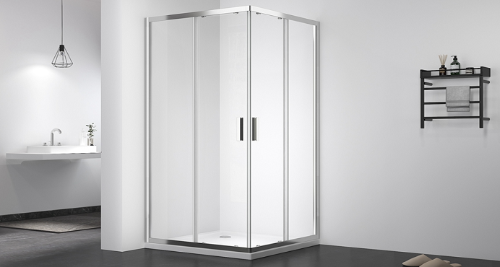The microstructure of tempered glass used in sliding door shower enclosures plays a crucial role in determining its mechanical strength. Tempered glass, also known as toughened glass, undergoes a specific heat treatment process that alters its internal structure, resulting in enhanced strength and safety features compared to standard annealed glass. Here’s a detailed explanation of how the microstructure affects the mechanical strength of tempered glass:
Tempering Process and Microstructure Changes
Heat Treatment: Tempered glass is produced by heating ordinary annealed glass to a temperature of around 620 to 650°C (1148 to 1202°F), which is near its softening point, and then rapidly cooling it. This rapid cooling process, known as quenching, is done using air jets directed at both surfaces of the glass.
Surface Compression: The rapid cooling causes the outer surfaces of the glass to cool and solidify more quickly than the interior. As the inner layers cool and contract, they pull on the outer surfaces, creating a state of high compressive stress on the surfaces.
Internal Tension: The interior of the glass, which cools more slowly, is left in a state of tensile stress. This stress distribution—compressive stress on the surface and tensile stress in the center—enhances the mechanical properties of the glass.
Stress Distribution and Mechanical Strength
Compressive Surface Stress: The compressive stress on the surface of tempered glass increases its resistance to breakage from surface impacts and scratches. Compressive stress helps to counteract tensile stresses that could lead to the initiation and propagation of cracks. It’s this compressive stress that significantly boosts the mechanical strength of the glass compared to its non-tempered counterpart.

Tensile Stress in the Core: The internal tensile stress, although a potential weak point, is confined within the core of the glass where it is less likely to be exposed to direct damage. The balance of compressive and tensile stresses creates a more robust and durable material that is less prone to catastrophic failure under normal conditions.
Increased Resistance to Impact and Bending
Impact Resistance: The surface compressive stress makes tempered glass much more resistant to impacts. When an object hits the glass, the energy is absorbed and distributed over a larger area, reducing the likelihood of crack formation and propagation. As a result, tempered glass can withstand impacts that would typically shatter standard glass.
Bending Strength: The internal stress profile enhances the bending strength of tempered glass. The compressive forces on the surface help to resist tensile forces that occur during bending, allowing the glass to flex more without breaking. This increased bending strength is crucial for applications like sliding door shower enclosures, where the glass must withstand various forces without fracturing.
Fragmentation Pattern and Safety
Controlled Fragmentation: If tempered glass does break, it shatters into small, blunt-edged fragments rather than sharp, jagged pieces. This is due to the internal tensile stresses, which cause the glass to release energy rapidly and break into numerous small pieces. The small, cuboidal fragments reduce the risk of serious injury, making tempered glass a safer choice for applications in shower enclosures.
Safety Benefits: The fragmentation pattern of tempered glass is a direct result of its microstructure. When a critical stress point is reached, the internal tensile stresses overcome the surface compressive stresses, causing the glass to shatter. This rapid energy release and fragmentation mechanism enhance the safety of tempered glass in environments where human impact is a concern, such as in bathrooms.
Enhanced Resistance to Thermal Stress
Thermal Stability: The tempering process improves the thermal resistance of the glass. The compressive stress on the surface helps to counteract thermal expansion and contraction, which can lead to cracks and breakage in standard glass. As a result, tempered glass can withstand greater temperature differentials, reducing the likelihood of thermal breakage.
Temperature Differentials: The ability to endure significant temperature variations is essential for shower enclosures, which may be exposed to both hot water and cooler ambient temperatures. The tempered glass’s enhanced thermal stability ensures that it remains intact and safe under such conditions.
Microstructure Analysis and Quality Control
Stress Testing: The quality and strength of tempered glass are often evaluated using techniques such as polarimetry, which can detect the stress patterns within the glass. These techniques ensure that the glass has the proper stress distribution necessary for optimal mechanical strength and safety.




 English
English Deutsch
Deutsch
















